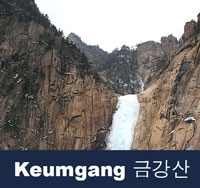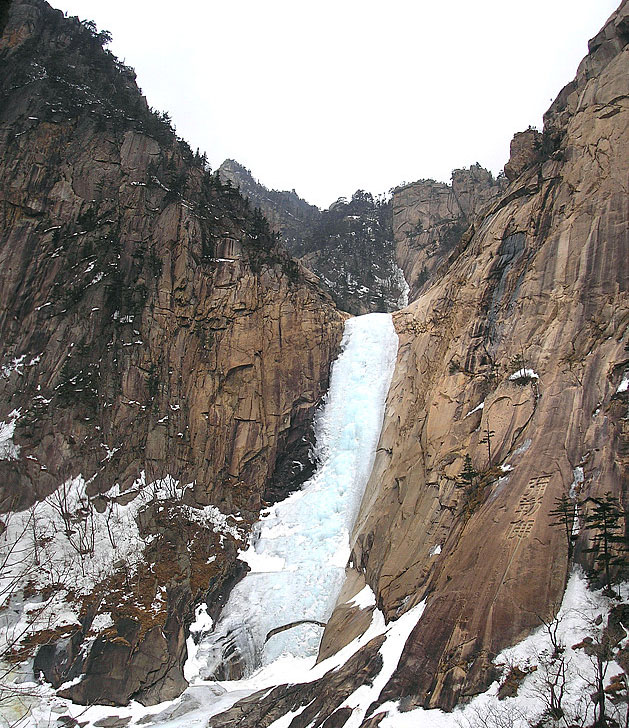Taekwondo 태권도Taekwondo Preschool
When you reach senior belt you are expected to guide the junior belts when they are beginning Taekwondo such as showing by example. To advance from one rank to the next, students typically complete promotion tests in which they demonstrate their proficiency in the various aspects of the art before a panel of judges or their teacher. View Taekwondo belt levels »

Keumgang 금강산
Kŭmgangsan (Korean pronunciation: [kɯmɡaŋsʰan]) is a 1,638-metre (5,374 ft)-high mountain in Kangwon-do, North Korea.
Kŭmgangsan (Korean pronunciation: [kɯmɡaŋsʰan]) is a 1,638-metre (5,374 ft)-high mountain in Kangwon-do, North Korea. It is about 50 kilometres (31 mi) from the South Korean city of Sokcho in Gangwon-do. It is one of the best-known mountains in North Korea. It is located on the east coast of the country, in Mount Kumgang Tourist Region, formerly part of Kangwŏn Province (38.58°N 128.17°E). Mount Kumgang is part of the Taebaek mountain range which runs along the east of the Korean peninsula. The name means Vajra (or Diamond) Mountain.
Seasonal Names
Mount Kumgang has been known for its scenic beauty since ancient times and is the subject of many different works of art. Including its spring name, Kŭmgang (Hangul: 금강산; hanja: 金剛), it has many different names for each season, but it is most widely known today in the Korean language as Kŭmgangsan. In summer it is called Pongraesan (봉래산, 蓬萊山: the place where a Spirit dwells); in autumn, Phung'aksan (풍악산, 楓岳山: hill of colored leaves, or 楓骨山: great mountain of colored leaves); in winter, Kaegolsan (개골산, 皆骨山: stone bone mountain).

Geography
The mountain consists almost entirely of granite and diorite, weathered over centuries into a wide variety of shapes, including over 12,000 picturesque stone formations, ravines, cliffs, stone pillars, and peaks.
Mount Kumgang is commonly divided into three areas: Inner Kŭmgang, Outer Kŭmgang, and Sea Kŭmgang, each with different geological and topographical features.
- Inner Kŭmgang is noted for its views. The Manpok ravine is popular with tourists.
- Outer Kŭmgang is noted for the large number of peaks. Chipson Peak (rock of ten thousand forms) is known for its many waterfalls.
- The Sea Kŭmgang area is known for the lagoons and stone pillars.
Environment
Much of the mountain is covered by mixed broadleaf and coniferous forest and protected in a 60,000 ha national park. Some 25,000 ha has been identified by BirdLife International as an Important Bird Area (IBA) because it supports endangered Red-crowned Cranes.
Mount Kumgang Tourist Region
Since 1998, South Korean tourists have been allowed to visit Mount Kumgang, initially travelling by cruise ship, but more commonly of late by coach. In 2002, the area around the mountain was separated from Kangwŏn Province and organized as a separately-administered Tourist Region. The land route was opened in 2003. A rail link exists on the North Korean side up to the border, but no tracks are laid between Gangneung and the border in South Korea.
In 1998, there were 15,500 tourists in November and December, in 1999 there were 148,000, and in 2000 213,000. In 2001 tourist numbers dropped to 58,000 amidst disagreements over the access over land. As of 2002, almost 500,000 have visited the Mount Kumgang Tourist Region. Tourist numbers have since established themselves at about 240,000 a year. In June 2005, Hyundai Asan announced the 1 millionth South Korean visit to the area.
The Mount Kumgang Tourist Region is thought to be one way for the North Korean government to receive hard currency from abroad. Therefore the official currency of the tour is neither the South Korean won nor the North Korean won, but the US dollar. Since 2003, food and services to South Korean tourists are provided by some North Koreans. But most of the staff in the hotels are Chinese citizens of Korean heritage with Korean language skills. The area is developed by Hyundai Asan, which plans to expand the site with a proper ski resort to complement the current sleigh course, and complete golf courses. Many plans for expansion, however, are in their earliest stages.
On the morning of July 11, 2008, a 53-year-old South-Korean tourist was shot and killed while walking on the resort's beach. Wang-ja entered a military area by crossing over a sand dune and was shot twice by North Korean soldiers. North Korea claimed that sentries had no choice but to shoot her because, despite their order to stop, she fled. South Korea demanded an on-the-spot survey, but North Korea declined it, claiming all the facts were clear and all responsibilities were the victim's and South Korea's. Due to the shooting, South Korea temporarily suspended all trips to Mount Kumgang. In March 2010, the DPRK government warned of "extraordinary measures" if the tourism ban were not lifted. On April 23, 2010, the North Korean government seized 5 properties owned by South Korea at the resort, saying that it was done "in compensation for the damage the North side suffered due to the suspension of the tour for a long period." In seizing the properties, North Korea also alluded to the Baengnyeong incident, showing displeasure with South Korea blaming North Korea for the sinking of the ship.
Since April 2010, North Korea is now permitting companies to run tours from the North Korean side, making it appear increasingly unlikely that tours will be resumed from the South. However, on October 1, 2010, news reports said, "Red Cross officials from the two Koreas agreed Friday to hold reunions for families separated by the Korean War amid mixed signals from North Korea on easing tensions over the sinking of a South Korean warship. One hundred families from each country will attend the meetings from Oct. 30 to Nov. 5 at a hotel and reunion center at the North's scenic Diamond Mountain resort, Unification Ministry spokeswoman Lee Jong-joo said."
As of September 2011 North Korea have begun operating cruises directly from Rason in north-eastern North Korea, to the port in Mount Kumgang, offering visitors the chance to stay in the resorts previously run by the south. Although they are aimed primarily at Chinese guests, western companies are also offering the tours.
Japanese map of Kongō-san, or Mount Kumgang in 1939.
An extremely attractive 1939 or Showa 14 panoramic view map of Kumgangsan or Diamond Mountain, North Korea. Also known as Mount Kumgang, Diamond Mountain is an important tourist destination in North Korea. Diamond Mountain is one of the few areas in North Korea that is open to foreign tourism and regularly visited by international travelers. The mountain is known for is dramatic views and stunning natural beauty. This uncommon type of map evolved out of traditional Japanese view-style cartography and began to appear in Japan, Taiwan, and Korea in the early 20th century. Generally speaking such maps coincided with the development of railroad lines throughout the once vast Dai Nippon Teikoku or Japanese Empire. It is a distinctive style full of artistic flourish that at the same time performs a practical function. This particular example is both relatively early and exceptionally beautiful. It was printed via a multi-color lithographic process with delicately shaded tones and a easily comprehensible intuitive design. Shows villages, famous sights, roadways, and rail lines. Folds into itself, accordion style, with an photographic cover depicting Diamond Mountain at the left end. Verso features additional Japanese text and a smaller transportation map.

There are five tenets defined in the International Taekwondo Federation (ITF) and several more in World Taekwondo (WT).
Integrity ( 염치 yeom-chi ): "Although it may be similar, this form of integrity takes on a more wider role then defined in the common dictionary. In taekwondo, integrity means not only to determine what is right or wrong but also having the conscience to feel guilt if one has done wrong and to have the integrity stand up for what is right." View Taekwondo Tenets »
Promotion from one dan to the next can take years. The general rule is that a black belt may advance from one rank to the next only after the number of years equivalent to the current rank. For example, a newly promoted third-degree black belt may not be allowed to advance to fourth-degree until three years have passed. View more information on Black Belt Dan ( 단 ) ».
RESOURCES
This article uses material from the Wikipedia article "Keumgang", which is released under the Creative Commons Attribution-Share-Alike License 3.0.














